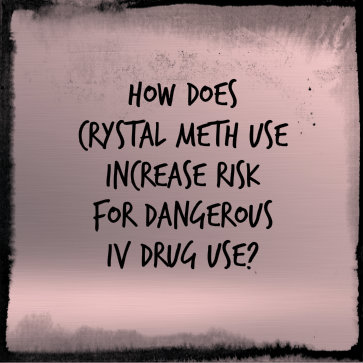How Crystal Meth Use Increases Risks For IV Drug Use
Crystal methamphetamine (crystal meth) is an illegal, illicitly produced form of methamphetamine, a tightly controlled stimulant drug with limited but real usefulness as a legitimate medication. People who use/abuse this illegal product run significant risks for developing a range of serious or potentially deadly health complications. According to the results of a study published in October 2013 in the Canadian Medical Association Journal, teenagers and young adults who use crystal meth substantially increase their chances of getting involved in IV (intravenous) drug use, a form of drug use strongly associated with severe substance-related health problems.
How Methamphetamine And Crystal Meth Effects The Body
 Methamphetamine is a close chemical relative of amphetamine; like that well-known stimulant medication, it produces euphoric sensations and sharply boosts the baseline activity rate inside the brain. Over time, the brain can get accustomed to methamphetamine’s effects and develop a dependence on the drug’s presence. In turn, dependence on methamphetamine is often a precursor for methamphetamine addiction, a highly disruptive and destructive combination of dependence, drug cravings and drug-oriented lifestyle patterns. Doctors occasionally prescribe legal, pharmaceutically manufactured methamphetamine to treat cases of narcolepsy, severe obesity or attention-deficit/hyperactivity disorder (ADHD).
Methamphetamine is a close chemical relative of amphetamine; like that well-known stimulant medication, it produces euphoric sensations and sharply boosts the baseline activity rate inside the brain. Over time, the brain can get accustomed to methamphetamine’s effects and develop a dependence on the drug’s presence. In turn, dependence on methamphetamine is often a precursor for methamphetamine addiction, a highly disruptive and destructive combination of dependence, drug cravings and drug-oriented lifestyle patterns. Doctors occasionally prescribe legal, pharmaceutically manufactured methamphetamine to treat cases of narcolepsy, severe obesity or attention-deficit/hyperactivity disorder (ADHD).
Crystal meth gets its name from its characteristic crystalline appearance. In America, most of the available supply of this drug comes from illegal, large-scale manufacturing facilities located on U.S. territory or in other countries. Some crystal meth also comes from small-scale operations that only service local areas. Depending on the process used during its creation, illegally made methamphetamine can contain a number of highly dangerous compounds, including sulfuric acid, acetone, hydrochloric acid or red phosphorus. Since use of crystal meth inevitably takes place outside of a legitimate medical context, it inherently constitutes a form of drug abuse. People who habitually use the drug have exceedingly high risks for developing an addiction or other major health problems such as drug overdoses, disturbed or violent mood shifts, extreme tooth and gum damage (meth mouth) and psychosis (hallucinations and/or delusional thought processes).
IV Drug Use
IV drug use is the common term for the purposeful injection of drugs directly into the bloodstream. As a rule, doctors and other medical professionals use this term in reference to the injection of recreational substances rather than medications. IV drug abusers commonly rely on direct bloodstream access to rapidly deliver substances to their brains, and thereby rapidly trigger the effects associated with those substances. IV drug injection carries risks above and beyond the risks classically associated with recreational drug use in general.
IV Drug Use Risks
- Increased chances of drug overdose
- Dangerous or lethal infections such as hiv/aids or hepatitis b or c
- Lethal infection-related complications such as bacteremia or sepsis
- Increased chances of developing pneumonia
- And increased chances of dangerous contaminants or additives
How Crystal Meth Use Increases Chance Of Falling Into IV Drug Use
In the study published in the Canadian Medical Association Journal, researchers from several Canadian institutions used information gathered from a project called the At-Risk Youth Study to examine the potential connection between crystal meth use and the initiation of IV drug use among teenagers and young adults between the ages of 14 and 26. All told, 991 individuals submitted answers to questionnaires regarding their baseline drug-using behaviors. At the beginning of the study, 395 of these individuals were crystal methamphetamine users, while another 390 were IV drug users. The researchers tracked the drug use patterns of all 991 participants over five years in order to uncover any developing trends.
Altogether, 16 percent of the participants not initially involved in IV drug use began taking drugs intravenously over the course of the study. After analyzing their data, the researchers found that the recent use of a non-injectable form of crystal methamphetamine is clearly linked to increased chances of beginning IV drug use. In most cases, prior users of non-injectable crystal meth choose this drug for their first forays into intravenous use. The researchers also found that the average young user of crystal meth who initiates IV drug intake makes the transition to intravenous use at the exceptionally early age of 14.
Meth Treatment Significantly Needed In City, Street Culture
The authors of the study published in the Canadian Medical Association Journal gathered their data from young people either living on the street or heavily involved in local street culture. They believe that their findings indicate an urgent need to address crystal methamphetamine use in this population and curb the transition to IV drug use.
Read More About The Connection Between Hepatitis C And IV Drug Users And Get Help Today!



